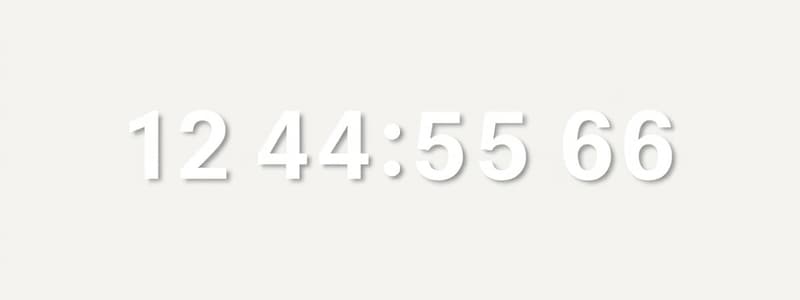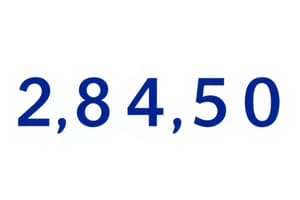Podcast
Questions and Answers
Which of the following statements is true about all natural numbers?
Which of the following statements is true about all natural numbers?
- Every natural number is also an integer. (correct)
- Every natural number is also a complex number.
- Every natural number is also a rational number. (correct)
- Every natural number is also an irrational number.
Which of the following numbers is classified as an irrational number?
Which of the following numbers is classified as an irrational number?
- $3$
- $ rac{7}{8}$
- $ rac{1}{2}$
- $ ext{π}$ (correct)
What is the definition of an irrational number?
What is the definition of an irrational number?
- A number that cannot be expressed in the form $ rac{p}{q}$ where q ≠ 0. (correct)
- A whole number that is not negative.
- A number that has a repeating decimal.
- A number that can be expressed as a fraction.
Which statement about integers is correct?
Which statement about integers is correct?
Who were the first to discover irrational numbers?
Who were the first to discover irrational numbers?
Which of the following pairs represents rational numbers?
Which of the following pairs represents rational numbers?
Which of the following is false regarding rational and irrational numbers?
Which of the following is false regarding rational and irrational numbers?
Which square root is classified as an irrational number?
Which square root is classified as an irrational number?
What is the method to create the points P2, P3, ..., Pn in the construction of the square root spiral?
What is the method to create the points P2, P3, ..., Pn in the construction of the square root spiral?
How can one distinguish between rational and irrational numbers using their decimal expansions?
How can one distinguish between rational and irrational numbers using their decimal expansions?
What is the decimal expansion of the rational number $\frac{1}{3}$?
What is the decimal expansion of the rational number $\frac{1}{3}$?
What characteristic do the remainders display in the first example given for finding decimal expansions?
What characteristic do the remainders display in the first example given for finding decimal expansions?
What is the purpose of visualizing real numbers on the number line using decimal expansions?
What is the purpose of visualizing real numbers on the number line using decimal expansions?
In constructing the square root spiral, what is the significance of the line segment drawn perpendicular to OPn–1?
In constructing the square root spiral, what is the significance of the line segment drawn perpendicular to OPn–1?
Which of the following best describes irrational numbers based on their decimal expansions?
Which of the following best describes irrational numbers based on their decimal expansions?
Given the decimal expansion 0.875, which rational number does it correspond to?
Given the decimal expansion 0.875, which rational number does it correspond to?
What happens to the remainders when dividing a number by its divisor?
What happens to the remainders when dividing a number by its divisor?
What can be inferred about the number of entries in the repeating string of remainders compared to the divisor?
What can be inferred about the number of entries in the repeating string of remainders compared to the divisor?
What type of decimal expansion is produced when the remainder eventually becomes zero?
What type of decimal expansion is produced when the remainder eventually becomes zero?
Which example illustrates a case where the decimal expansion is non-terminating recurring?
Which example illustrates a case where the decimal expansion is non-terminating recurring?
When the remainder does not become zero during division, what is observed in the quotient?
When the remainder does not become zero during division, what is observed in the quotient?
What happens with the decimal expansion of fractions like 7/8?
What happens with the decimal expansion of fractions like 7/8?
What is the characteristic of the remainders in the case of 10 divided by 3?
What is the characteristic of the remainders in the case of 10 divided by 3?
What is the decimal expansion of the fraction 1/7?
What is the decimal expansion of the fraction 1/7?
Which method can be used to find a rational number between two numbers r and s?
Which method can be used to find a rational number between two numbers r and s?
How many rational numbers can be found between 1 and 2?
How many rational numbers can be found between 1 and 2?
What kind of numbers are left on the number line between identified rational numbers?
What kind of numbers are left on the number line between identified rational numbers?
Which of the following is a valid rational number representation for zero?
Which of the following is a valid rational number representation for zero?
If 1 is represented with a denominator of 6, what would be its equivalent form?
If 1 is represented with a denominator of 6, what would be its equivalent form?
Which of the following correctly identifies the rational numbers between 1 and 2 when using denominators of 6?
Which of the following correctly identifies the rational numbers between 1 and 2 when using denominators of 6?
Which statement best describes the relationship between rational numbers and irrational numbers?
Which statement best describes the relationship between rational numbers and irrational numbers?
Which of the following includes inaccuracies regarding rational numbers?
Which of the following includes inaccuracies regarding rational numbers?
What is the nature of the number $2 + 3$?
What is the nature of the number $2 + 3$?
Which of these statements about operations involving irrational numbers is correct?
Which of these statements about operations involving irrational numbers is correct?
What is the result of dividing $8 15$ by $2 3$?
What is the result of dividing $8 15$ by $2 3$?
What type of decimal expansion do the numbers $2 + 21$, $π - 2$, and $7 5$ exhibit?
What type of decimal expansion do the numbers $2 + 21$, $π - 2$, and $7 5$ exhibit?
If $a$ is a natural number, what does $a = b$ signify?
If $a$ is a natural number, what does $a = b$ signify?
What can be concluded when adding or subtracting two irrational numbers?
What can be concluded when adding or subtracting two irrational numbers?
What geometric representation can be used to find the square root of a positive real number?
What geometric representation can be used to find the square root of a positive real number?
What is the result of multiplying $6 5$ by $2 5$?
What is the result of multiplying $6 5$ by $2 5$?
Flashcards are hidden until you start studying
Study Notes
Rational Numbers
- Any number that can be expressed in the form p/q, where p and q are integers and q ≠ 0.
- Can be found between any two rational numbers.
- There are infinitely many rational numbers between any two given rational numbers.
Irrational Numbers
- Numbers that cannot be expressed in the form p/q, where p and q are integers and q ≠ 0.
- Examples include √2, √3, √5, π, and 0.10110111011110...
- There are infinitely many irrational numbers.
Decimal Expansions of Real Numbers
- Rational Numbers:
- Terminating Decimal: The decimal expansion ends after a finite number of steps (e.g., 7/8 = 0.875).
- Non-Terminating Recurring Decimal: The decimal expansion goes on forever, with a repeating block of digits (e.g., 10/3 = 3.333...).
- Irrational Numbers:
- Non-Terminating Non-Recurring Decimal: The decimal expansion goes on forever and does not have a repeating block of digits (e.g., √2 = 1.4142... ).
Operations with Irrational Numbers
- Sum or Difference: The sum or difference of a rational number and an irrational number is always irrational.
- Product or Quotient: The product or quotient of a non-zero rational number and an irrational number is always irrational.
- Sum or Difference of Two Irrationals: The result of adding, subtracting, multiplying, or dividing two irrational numbers can be either rational or irrational.
Square Roots of Real Numbers
- Definition: For a real number a > 0, √a = b means b² = a and b > 0.
Geometric Representation of Square Roots
- Square roots of real numbers can be represented geometrically by constructing a spiral on the number line.
Studying That Suits You
Use AI to generate personalized quizzes and flashcards to suit your learning preferences.




